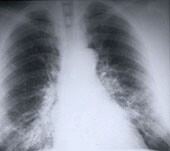
TUESDAY, Nov. 23 (HealthDay News) — A less invasive method for finding out whether lung cancer has spread to the lymph nodes could prevent many unnecessary operations, a new study suggests.
This process, called staging, is usually done via a major operation called a thoracotomy. If the cancer is confined to the lung, then the operation can remove the cancer. However, if the cancer has spread, then it is an unnecessary procedure, which only serves to increase the patient’s discomfort.
The much less invasive procedure, called an endosonography, combines ultrasound of internal organs with the use of a fiberoptic endoscope, which can also biopsy the lymph nodes.
“We found that a new strategy using ultrasound is better to check for metastasis than traditional surgical staging,” said lead researcher Dr. Jouke T. Annema, director of Endosonography for Pulmonary Medicine at Leiden University Medical Center in the Netherlands.
Staging the cancer is important, because the type of treatment depends on whether the cancer has spread beyond the lung or not.
If the lymph nodes are cancer-free, the patients will be treated by removing the cancer from the lung, Annema said. If there is cancer in the lymph nodes, then the treatment is completely different, with chemotherapy and radiation, he explained.
The current standard of thoracotomy to stage cancer results in many patients not receiving the best treatment, Annema said. Using endosonography will make it possible to reduce unnecessary lung operations by half, he added.
The findings are published in the Nov. 24 issue of the Journal of the American Medical Association.
The study follows on the heels of a major U.S. government report that found that annual screening for lung cancer with low-dose CT scans cut death rates in older, current or former heavy smokers by 20 percent. The scans also reduced death rates for any cause by 7 percent.
Given that lung cancer is the nation’s leading cancer killer, this new study is another piece of good news.
For the current study, Annema and colleagues compared less invasive staging of lung cancer using endosonography, which combined transesophageal and endobronchial ultrasound, with surgery in 241 lung cancer patients.
These patients underwent either surgery or endosonography followed by surgery when no nodal metastases were found at endosonography.
Of the 241 patients, 118 had surgical staging and 123 endosonography. Of those who received endosonography, 65 also underwent surgery, the researchers noted.
Among the patients whose cancer had spread beyond the lung, 41 (35 percent) were identified by surgery, while 56 (46 percent) were spotted by endosonography and 62 (50 percent) were pinpointed after endosonography followed by surgery.
There were 21 unnecessary surgeries in the surgical group (18 percent), compared with nine (7 percent) in the endosonography group, Annema’s team found.
In addition, there was no difference in the rate of complications between the groups, they note.
“We expect current guidelines will be changed,” Annema said.
Commenting on the study, Dr. Len Horovitz, a pulmonary specialist at Lenox Hill Hospital in New York City, said that, “if this can be borne out in larger trials, going to thoracotomy to stage patients may not be necessary.”
If you can spare someone with extensive disease a thoracotomy with the chances of complications and extensive healing time, treatment with chemotherapy and radiation can start much sooner, he said.
“If you do an unnecessary thoracotomy, you are really delaying treatment,” Horovitz said. Before this new method could become standard care, doctors would need to be trained in the technique, he added.
Another expert agrees this new technique could be a better option than a thoracotomy for diagnosing the stage of lung cancer.
Dr. Otis W. Brawley, chief medical officer at the American Cancer Society, added that “to me it seems like a better way of staging patients prior to surgery.”
The big advantage of this new technique is that it will spare patients with advanced lung cancer needless surgery, he said.
“This has the potential of becoming standard care,” Brawley said. “I will predict that it will become standard in many of the cancer centers that specialize in lung cancer.”
More information
For more information on lung cancer, visit the U.S. National Cancer Institute.

